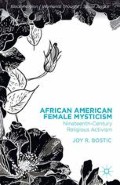Abstract
Jarena Lee’s The Life and Religious Experience of Jarena Lee, was first published in 1836. Later Lee published a more expanded account of her spiritual journey and ministerial travels in an 1849 edition. As the earliest known spiritual autobiography written by an African American woman, Lee’s narrative serves as an important source for developing an understanding of African American female mysticism.1 In this endeavor, Jarena Lee may serve as a paradigmatic figure for black female mystical activism. She is an archetypal persona parallel to the Orisha, lwa, or the ancestors who inhabit individuals via possession or revisit the living by being “re-born” through descendants during Yoruba or Vodou rituals. It is within this liminal space that these personas inform and commune with the gathered community. For the purposes of this study, Lee’s text provides this incarnational, self-reflective, emancipatory mystical space in which the archetypal patterns of African American womanhood can inform our understanding of black female mysticism.
Access this chapter
Tax calculation will be finalised at checkout
Purchases are for personal use only
Preview
Unable to display preview. Download preview PDF.
Notes
Joy R. Bostic, “Mystical Experience, Radical Subjectification, and Activism in the Religious Traditions of African American Women,” in Mysticism and Social Transformation, ed. J. K. Ruffing (Syracuse, NY: Syracuse University Press, 2001), 145.
Mary Niall Mitchell, Raising Freedom’s Child: Black Children and Visions of the Future After Slavery (New York: New York University Press, 2008).
Maria W. Stewart et al., Spiritual Narratives, The Schomburg Library of Nineteenth-century Black Women Writers (New York: Oxford University Press, 1988), 18.
Herbert G. Gutman, The Black Family in Slavery and Freedom, 1750– 1925 (New York: Vintage Books, 1977), 599. See note 35.
Gwyn Campbell, “Children and Slavery in the New World: A Review,” Slavery & Abolition 27, no. 2 (August 2006): 270.
Bert James Loewenberg and Ruth Bogin, Black Women in Nineteenth-Century American Life: Their Words, Their Thoughts, Their Feelings (University Park: Pennsylvania State University Press, 1976), 126.
William L. Andrews, ed., Sisters of the Spirit: Three Black Women’s Autobiographies of the Nineteenth Century, Religion in North America (Bloomington: Indiana University Press, 1986), 27–28.
Renee K. Harrison, Enslaved Women and the Art of Resistance in Antebellum America (New York: Palgrave Macmillan, 2009), 142.
Dianne M. Stewart, Three Eyes for the Journey: African Dimensions of the Jamaican Religious Experience (New York: Oxford University Press, 2005), 94.
Anne Rebecca Elliott, African American Women’s Understandings of the Spirit: Ancient Eastern Pneumatological Influences (New York, NY: Union Theological Seminary, 1998), 237.
Alison Weber explores the ways in which Teresa of Avila uses language and literary conventions in her writings as “conscious rhetorical devices.” See Alison Weber, Teresa of Avila and the Rhetoric of Feminity (Princeton, NY: Princeton University Press, 1990), 3–4.
James Craig Holte, The Conversion Experience in America: A Sourcebook on Religious Conversion Autobiography (New York: Greenwood Press, 1992). xi.
Mathieu Deflem, “Ritual, Anti-Structure, and Religion: A Discussion of Victor Turner’s Processual Symbolic Analysis,” Journal for the Scientific Study of Religion 30, no. 1 (March 1, 1991): 8.
Albert J. Raboteau, Slave Religion: The “Invisible Institution” in the Antebellum South, Updated (New York: Oxford University Press, 2004), 74.
George White, Black Itinerants of the Gospel: The Narratives of John Jea and George White, 1st Palgrave ed. (New York: Palgrave, 2002).
Bernard McGinn, The Essential Writings of Christian Mysticism (New York: Modern Library, 2006).
Finnian N. Nwaozor, Studies in African and Medieval European Mysticism (Lincoln: University of Nebraska-Lincoln, May 2002). Nwaozor discusses the prevalence and role of mystical flight in African mysticisms. He also describes the significance of symbols of death and rebirth in African mystical traditions.
Clifton H. Johnson, ed., God Struck Me Dead: Voices of Ex-Slaves, 2nd ed. (Cleveland, OH: The Pilgrim Press, 1969), 63.
Charles H. Long, “Indigenous People, Materialities, and Religion: Outline for a New Orientation to Religious Meaning,” in Religion and Global Culture: New Terrain in the Study of Religion and the Work of Charles H. Long, ed. Jennifer I. M. Reid (Oxford, UK: Lexington Books, 2003), 180.
Jonathan Edwards, Sinners in the Hands of an Angry God, (New Haven, CT: Yale University Press, 2010), 43.
Robert Farris Thompson, Flash of the Spirit: African and Afro-American Art and Philosophy, 1st ed. (New York: Random House, 1983).
Yvonne Patricia Chireau, Black Magic: Religion and the African American Conjuring Tradition (Berkeley, CA: University of California Press, 2003). As a container the hand is not fixed or rigid in its use or contents. It may be enhanced or recharged by adding new materials and making new configurations.
Sue Houchins, “Introduction,” in Spiritual Narratives (New York: Oxford University Press, 1988), xxxvii.
Joy R. Bostic, “‘Flesh That Dances’: A Theology of Sexuality and the Spirit in Toni Morrison’s Beloved,” in The Embrace of Eros: Bodies, Desires, and Sexuality in Christianity, ed. Margaret D. Kamitsuka (Minneapolis: Fortress Press, 2010), 280.
Jean McMahon Humez, Gifts of Power: The Writings of Rebecca Jackson, Black Visionary, Shaker Eldress, Illustrated ed. (Amherst: University of Massachusetts Press, 1987), 72.
Quoted in Diana L. Hayes, Forged in the Fiery Furnace: African American Spirituality (Maryknoll, NY: Orbis, 2012), 161.
Riggins R. Earl, Dark Symbols, Obscure Signs: God, Self, and Community in the Slave Mind (Maryknoll, NY: Orbis Books, 1993), 58.
Copyright information
© 2013 Joy R. Bostic
About this chapter
Cite this chapter
Bostic, J.R. (2013). Standing upon the Precipice: Community, Evil, and Black Female Subjectivity. In: African American Female Mysticism. Black Religion / Womanist Thought / Social Justice. Palgrave Macmillan, New York. https://doi.org/10.1057/9781137375056_3
Download citation
DOI: https://doi.org/10.1057/9781137375056_3
Publisher Name: Palgrave Macmillan, New York
Print ISBN: 978-1-349-47676-3
Online ISBN: 978-1-137-37505-6
eBook Packages: Palgrave Religion & Philosophy CollectionPhilosophy and Religion (R0)

